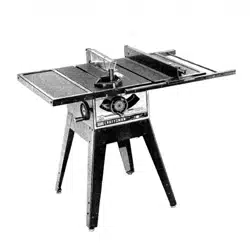Loading ...
Loading ...
Loading ...

RABBETING
Rabbeting is known as cutting out a section of the corner
of a piece of material, acrossan end or along an edge.
To make a RABBET requires cuts which do not go all the
way through the material. Therefore the blade guard must
be removed.
1. Remove blade guard.
2. For rabbeting along an edge (long way of workpiece) as
shown, add facing to rip fence (see 5. RIP FENCE, p.
16) approximately as high as the workpiece is wide.
Adjust rip fence and blade to required dimensions; then
make first cut with board flat on table asany rip (type)
cut; make second cut with workpiece on edge. Follow
all precautions, safety instructions, and operational
instructions as for ripping, or rip type operations,
including feather boardsand push stick, etc.
3. For rabbeting across an end, for workpiece 10½" and
RABBET
CUT
narrower make the rabbet cut with the board flat on
the table using the miter gage fitted with a facing (per
"6. MITER GAUGE" on p. 16). DO NOT use the rip
fence.
4. INSTALL BLADE GUARD IMMEDIATELY UPON
COMPLETION OF RABBETING OPERATION.
Rabbet cuts can also be made using the dado head or
molding head.
DADOING
Instructions for operating the Dado Head are contained in
booklet furnished with the Dado Head.
The recommended Dado Head is listed, under
recommended Accessories.
The arbor on the saw, is only long enough so that the
widest cut that can be made is 13/16" wide.
When installing the dado head on the arbor, ALWAYS
install the inside "loose collar" first.
It is not necessaryto install the outside loose collar before
screwing on the arbor nut. Make sure the arbor nut istight.
ALWAYS USE DADO INSERT LISTED UNDER
RECOMMEND ED ACCESSOR IES.
When using the dadoing head it will be necessaryto remove
the Blade Guard and Spreader, USE CAUTION. Use
feath erboards and pushsticks as required.
ALWAYS REPLACE THE BLADE GUARD AND
SPREADER WHEN YOU ARE FINISHED DADOING.
When using the molding head it will be necessary to remove
the Blade Guard and Spreader. USE CAUTION. Use
featherboards and push sticks, etc. as required.
MOLDING CUTTING
Instructions for operating the Molding Head are contained
in a booklet turnished with the Molding Head.
SAW TABLE DADO INSERT
\ //
HEAD
USING FEATHERBOARDS
ARBOR NUT
The recommended molding head is listed under
recommended Accessories.
Always use Molding Insert listed under recommended
Accessories.
When using the molding head it will be necessary to remove
the Blade Guard and Spreader. USE CAUTION. Use
featherboards and pushsticks as required.
ALWAYS REPLACE THE BL.ADE GUARD AND
SPREADER WHEN YOU ARE FINISHED MOLDING.
Add 8 inch high flat facing board to the fence, the full
length of the fence.
Use featherboards for all non "thru-sawing" operations
(when sawblade guard must be removed). Featherboards are
used to keep the work in contact with the fence and table
as shown, and to stop kickbacks.
Mount featherboards to fence and table as shown, so that
leading edges of featherboards will support workpiece until
cut is complete, and the workpiece has been pushed
completely past the cutter (sawblade, dado head, molding
head, etcr-) with a pushstick, as in ripping.
Before starting the operation (switch "OFF" and cutter
below table surface) :
(a) Install featherboards so they exert pressure on the
workpiece; be positive they are secure, and
(b) Make sure by trial that the featherboards will stop a
kickback if one should occur.
Featherboards are not employed during non thru-sawing
operations when using the miter gage.
Replace the sawblade guard as soon as the non thru-sawing
operation is complete.
"C" CLAMPS
WORK SUPPORT
FEATHERBOARD
"C" CLAMPS
"C" CLAMPS
23
Loading ...
Loading ...
Loading ...
